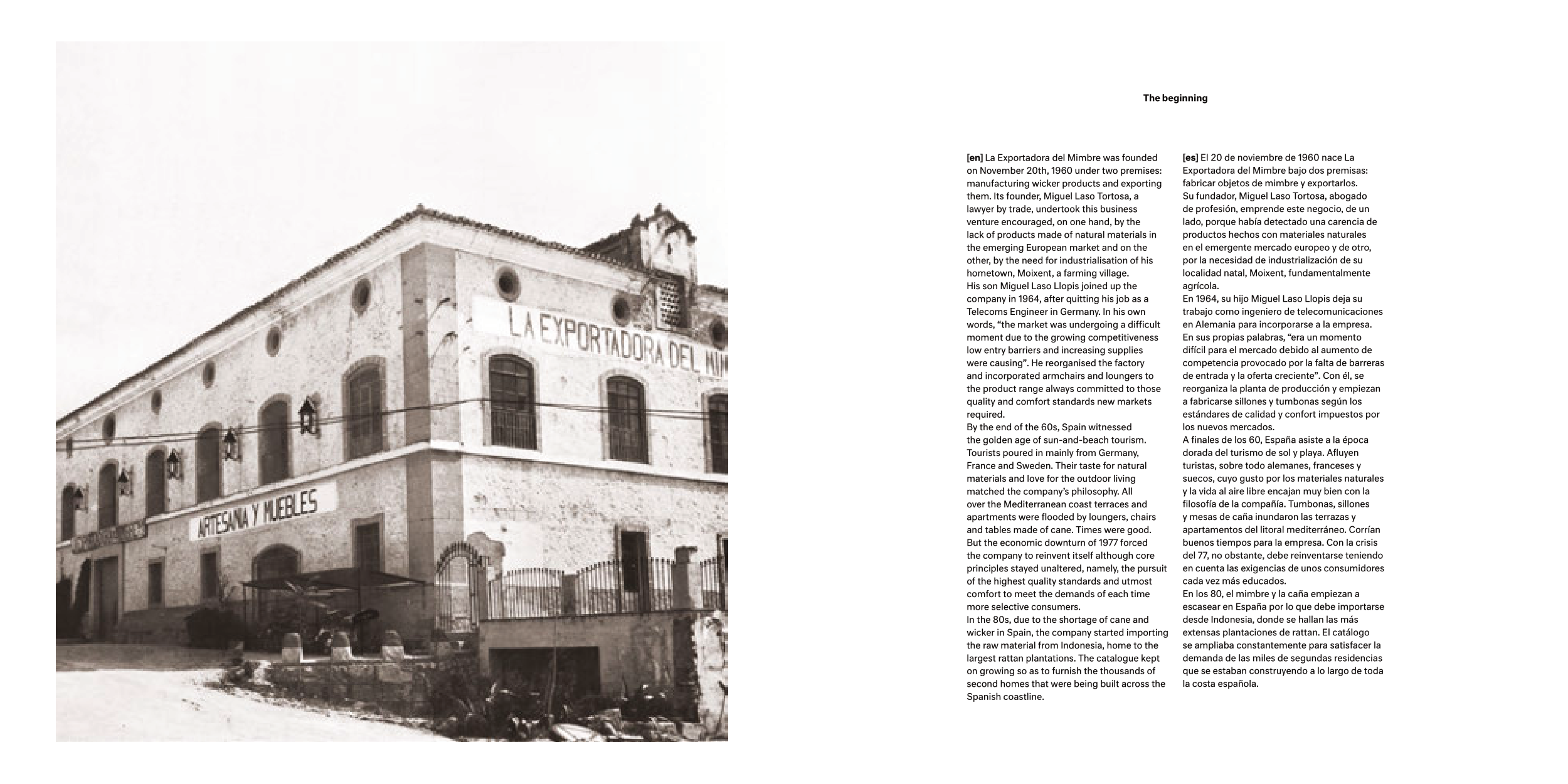[en] La Exportadora del Mimbre was founded
on November 20th, 1960 under two premises:
manufacturing wicker products and exporting
them. Its founder, Miguel Laso Tortosa, a
lawyer by trade, undertook this business
venture encouraged, on one hand, by the
lack of products made of natural materials in
the emerging European market and on the
other, by the need for industrialisation of his
hometown, Moixent, a farming village.
His son Miguel Laso Llopis joined up the
company in 1964, after quitting his job as a
Telecoms Engineer in Germany. In his own
words, “the market was undergoing a difficult
moment due to the growing competitiveness
low entry barriers and increasing supplies
were causing”. He reorganised the factory
and incorporated armchairs and loungers to
the product range always committed to those
quality and comfort standards new markets
required.
By the end of the 60s, Spain witnessed
the golden age of sun-and-beach tourism.
Tourists poured in mainly from Germany,
France and Sweden. Their taste for natural
materials and love for the outdoor living
matched the company’s philosophy. All
over the Mediterranean coast terraces and
apartments were flooded by loungers, chairs
and tables made of cane. Times were good.
But the economic downturn of 1977 forced
the company to reinvent itself although core
principles stayed unaltered, namely, the pursuit
of the highest quality standards and utmost
comfort to meet the demands of each time
more selective consumers.
In the 80s, due to the shortage of cane and
wicker in Spain, the company started importing
the raw material from Indonesia, home to the
largest rattan plantations. The catalogue kept
on growing so as to furnish the thousands of
second homes that were being built across the
Spanish coastline.
[es] El 20 de noviembre de 1960 nace La
Exportadora del Mimbre bajo dos premisas:
fabricar objetos de mimbre y exportarlos.
Su fundador, Miguel Laso Tortosa, abogado
de profesión, emprende este negocio, de un
lado, porque había detectado una carencia de
productos hechos con materiales naturales
en el emergente mercado europeo y de otro,
por la necesidad de industrialización de su
localidad natal, Moixent, fundamentalmente
agrícola.
En 1964, su hijo Miguel Laso Llopis deja su
trabajo como ingeniero de telecomunicaciones
en Alemania para incorporarse a la empresa.
En sus propias palabras, “era un momento
difícil para el mercado debido al aumento de
competencia provocado por la falta de barreras
de entrada y la oferta creciente”. Con él, se
reorganiza la planta de producción y empiezan
a fabricarse sillones y tumbonas según los
estándares de calidad y confort impuestos por
los nuevos mercados.
A finales de los 60, España asiste a la época
dorada del turismo de sol y playa. Afluyen
turistas, sobre todo alemanes, franceses y
suecos, cuyo gusto por los materiales naturales
y la vida al aire libre encajan muy bien con la
filosofía de la compañía. Tumbonas, sillones
y mesas de caña inundaron las terrazas y
apartamentos del litoral mediterráneo. Corrían
buenos tiempos para la empresa. Con la crisis
del 77, no obstante, debe reinventarse teniendo
en cuenta las exigencias de unos consumidores
cada vez más educados.
En los 80, el mimbre y la caña empiezan a
escasear en España por lo que debe importarse
desde Indonesia, donde se hallan las más
extensas plantaciones de rattan. El catálogo
se ampliaba constantemente para satisfacer la
demanda de las miles de segundas residencias
que se estaban construyendo a lo largo de toda
la costa española.
The beginning


